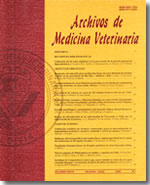Genetic-economic comparison of New Zealand Holstein and Jersey-New Zealand Holstein cross under a pastoral scheme in southern Chile
Main Article Content
Abstract
Chilean bovine dairy production needs to increase milk solid content. This study evaluates and compares genetic and economic progress of New Zealand Holstein (HoNZ) and New Zealand Jersey-HoNz crossbreed (Fx) using selection indices. The traits analysed were: milk (L) with 3% fat and 3% protein (LB), fat (kg) over 3% in LB (PF), protein (kg) over 3% in LB (PP) and body weight (BW). A multivariate mixed model was used for genetic parameters estimation using AIREMLF90 software. Economic values were estimated using costs associated with dry matter (DM) intake required to supply energy requirements of each trait and income as defined by PROLESUR payment to producer scheme for LB, PF and PP. Genetic progress of PF, PP and BW were similar for the two studied genotypes, but LB progress was higher in HoNz. Economic progress was similar between genotypes, but the offspring of Fx achieves a greater economic benefit per animal and per surface of land, due to higher production of PF and PP. Genetic improvement of Fx using a selection index, allows to achieve higher average of solids production and higher economic benefit.

